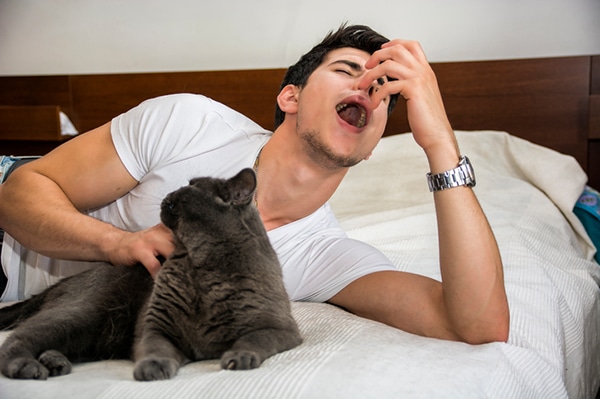According to The National Institute of Allergy and Infectious Diseases, between 6 and 10 million Americans are allergic to cats or other pets. If you’re an allergy sufferer who also happens to be a cat lover, you may be interested in low-allergen cats. But what makes a cat hypoallergenic? Low-allergen, or hypoallergenic cats, are those that typically produce fewer allergens than “regular” cats. The operative word here is “fewer.” Hypoallergenic cats and hypoallergenic cat breeds are not synonymous with non-allergenic, and no cat breed is completely non-allergenic.
A protein (Fel D1) is the allergen in the cat’s saliva is what causes problems for cat allergy sufferers. Once your cat licks her coat, the allergen-laden spit dries and becomes airborne, seeking a warm home in your nose and sinuses. Some cat breeds produce less of this protein than others, making them hypoallergenic.
What Factors Into Making Hypoallergenic Cats Hypoallergenic?

- Males produce more allergenic secretions than females
- Intact males produce more than neutered males
- Dark cats tend to produce more than light-colored ones (no one knows why)
- Kittens produce fewer allergens than adults
So, a light-colored female cat might work out better for people with cat allergies.
What Hypoallergenic Cats Are Out There?
As mentioned, although no cat breed is truly hypoallergenic — all cats produce at least some allergens— there are a few breeds that produce fewer allergens than others. This list of hypoallergenic cats should not be the only thing you consider when researching which breed of cat to adopt, however. Be sure to consider all of each breed’s characteristics to determine which is the best fit for your household.
List of 7 Hypoallergenic Cats

Three of the seven hypoallergenic cats are Oriental lines
The Balinese, Oriental Shorthair and Javanese are considered hypoallergenic cats. This provides several options for cat lovers who’d like a low-allergen cat with the characteristics of the popular Siamese.
- Balinese: Often referred to as the “long-haired Siamese,” the Balinese looks like an unlikely candidate for a hypoallergenic cat. But it is one of the few breeds that produces less of the Fel D1 protein than other cats, thus causing fewer allergic reactions in allergy sufferers.
- Oriental Shorthair: They’re hypoallergenic cats, but it’s still a good practice to groom your cats frequently (brushing as well as wiping her down) to keep dander to a minimum.
- Javanese: Like the Balinese, the Javanese sports a medium-long single coat that doesn’t mat. Because of the lack of undercoat, they have less fur, which translates into fewer allergens.
Two “Rex” cats are on the hypoallergenic cats list
The Devon and Cornish Rex make the list of hypoallergenic cats. Both shed very little fur, which is good news for allergy sufferers.
- Devon Rex: Of the two, the Devon has both shorter fur and less fur. Your Devon Rex will need to have her paw pads and ears cleaned of oil build-up frequently, but doesn’t need frequent full baths like the Sphynx or Cornish Rex.
- Cornish Rex: The Cornish Rex requires more upkeep than the Devon because this breed requires frequent baths to mitigate the oil buildup on his skin.
The last two hypoallergenic cats on the list offer you a choice of hairless or hairy
- Sphynx: The hairless Sphynx is the cat who most often comes to mind when people think about hypoallergenic cats. Being hairless does not mean they’re maintenance-free, however. Your Sphynx will need frequent baths to remove the gummy buildup of oils on her skin, and her large ears will also require frequent cleanings.
- Siberian: Like the Balinese, the Siberian sports a moderately long coat, but still is hypoallergenic due to the lower-than-average enzyme levels in their saliva. Some claim that 75 percent of cat allergy sufferers have no reaction to the Siberian.
What to Know After You’ve Brought Hypoallergenic Cats Home
It’s important to understand that adopting hypoallergenic cats may not be the panacea you’re expecting. Before you adopt a cat, spend some time with her or a cat of the same breed to see if your allergies remain in check.
If you’re getting your cat from a breeder, ask if you can return the cat if your allergies remain a problem (reputable breeders will allow you to do so). Even better, adopt from a rescue organization for the breed; they will always accept returns.
How to Minimize Cat Allergens, Whether You Have Hypoallergenic Cats or Not
- Reduce Allergens By Giving Your Cat Frequent Baths and Brushing. If you’re allergic, the process is best left to a groomer or family member. Research has proven that washing your cat 2 -3 times a week can remove up to 84 percent of existing allergens and reduce the future production of allergens. Some claim that using cool, distilled water in the bath may also reduce allergen levels. Frequent brushing will reduce the amount of hair and dander loose in your home.
- Wash Toys and Cat Bedding. Washing cat toys and cat bedding also reduces the number of allergens floating around your home. Do so at least once a week.
- Be Careful When Touching Your Cat. After touching your cat, wash your face and hands. Never touch your eyes or face before you’ve done so.
Learn More About Hypoallergenic Cats
If you’re an allergy sufferer who is serious about adding a cat to your household, read The Sneeze-Free Cat Owner by Diane Morgan. It provides extensive information on allergy management, including natural and homeopathic treatments for cat allergy sufferers.
Plus, read up on how to effectively manage your nasal allergies >>
Thumbnail: Photography by Art-Of-Photo / Thinkstock.
This piece was originally published in 2016.
About the authors
Catster is a cat magazine and cat website where cat lovers come together and learn about everything from weird cat sounds to serious feline health concerns. Subscribe to Catster magazine at www.catster.com/subscribe. Reach out here. Or, connect with us on Catster’s online community.








